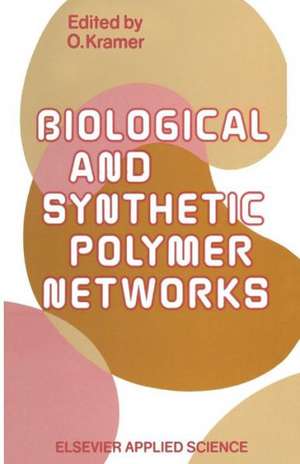Biological and Synthetic Polymer Networks
Editat de O. Krameren Limba Engleză Paperback – 6 oct 2011
Preț: 397.76 lei
Nou
Puncte Express: 597
Preț estimativ în valută:
76.11€ • 81.39$ • 63.46£
76.11€ • 81.39$ • 63.46£
Carte tipărită la comandă
Livrare economică 17 aprilie-01 mai
Preluare comenzi: 021 569.72.76
Specificații
ISBN-13: 9789401070973
ISBN-10: 9401070970
Pagini: 564
Ilustrații: 548 p.
Dimensiuni: 140 x 216 x 30 mm
Greutate: 0.64 kg
Ediția:Softcover reprint of the original 1st ed. 1988
Editura: SPRINGER NETHERLANDS
Colecția Springer
Locul publicării:Dordrecht, Netherlands
ISBN-10: 9401070970
Pagini: 564
Ilustrații: 548 p.
Dimensiuni: 140 x 216 x 30 mm
Greutate: 0.64 kg
Ediția:Softcover reprint of the original 1st ed. 1988
Editura: SPRINGER NETHERLANDS
Colecția Springer
Locul publicării:Dordrecht, Netherlands
Public țintă
ResearchCuprins
Introductory Paper.- 1. Covalent, Thermoreversible and Entangled Networks: An Attempt at Comparison.- Section 1: Biological Networks.- 2. Structure and Rheology of Fibrin Networks.- 3. Non-Gaussian Elastic Properties in Biopolymer Networks.- 4. Fibrinogen and Fibrin Studied by Small-angle Neutron Scattering.- 5. The Effect of Gelation on Water—Protein Interaction.- 6. Structure Determination of Different Casein Components.- 7. Galactomannan—Borate Systems: A Complexation Study.- 8. Formation of Thermally Reversible Networks from Starch Polysaccharides.- 9. Insect Cuticle as a Covalently Crosslinked Protein Network.- Section 2: Formation of Networks.- 10. Intramolecular Reaction and Network Formation and Properties.- 11. The Physics of Temporary Polymer Networks: A Comparison of Theory and Experiment.- 12. Kinetics of Ring Formation in Polymerization Reactions.- 13. Calculation of Average Network Parameters Using Combined Kinetic and Markovian Analysis.- 14. Effect of Dilution during Network Formation on Cyclization and Topological Constraints in Polyurethane Networks.- 15. 13C-NMR Analysis of Crosslinking Sites in Branched Polyesters.- 16. Fluoroelastomers: Reaction Products in Early Stages of Network Formation.- 17. A Model for Inhomogeneous Network Formation by Chainreaction Polymerization.- 18. Sol—Gel Transition Induced by Friedel—Crafts Crosslinking of Polystyrene Solutions.- 19. Physico-chemistry of the Hydrolysed Polyacrylamide—Chromium III Interaction in Relation to Rheological Properties.- 20. Cured Epoxy Resins: Measurements in Dilute and Semidilute Solution.- 21. Networks as the Basis of Pre-thickening SMC.- 22. Special Features of Network Build-up in Curing of Polyepoxides Based on N,N-Diglycidylaniline Derivatives.- 23. The Influence ofVitrification on the Formation of Densely Crosslinked Networks Using Photopolymerization.- Section 3: Characterisation of Polymer Networks.- 24. Orientational Behaviour of Free Polymer Chains Dissolved in a Strained Network: A Deuterium Magnetic Resonance Investigation.- 25. Polymer Coil Relaxation in Uniaxially Elongated Poly(ethylethylene) Observed by Small-angle Neutron Scattering.- 26. The Scattering of Light by Swollen Networks.- Section 4: Swelling of Polymer Networks.- 27. Swelling of Polymer Networks.- 28. Differential Swelling of Elastomers.- 29. Phase Transition in Swollen Gels. 10. Effect of the Positive Charge and its Position in the Side Chain on the Collapse and Mechanical Behaviour of Poly(acrylamide) Networks.- 30. Deswelling of Gels Induced by Unidirectional Compression.- 31. On the Temperature Dependence of Equilibrium Concentration of Slightly Crosslinked Gels.- 32. NMR Approach to the Swelling Process of PDMS Networks and Silica-filled Siloxanes,.- 33. Investigation on Polystyrene Networks Containing Pendent Poly(ethylene oxide) Chains.- Section 5: Rubber Elasticity.- 34. Anisotropy of Rubber Networks Crosslinked in States of Strain.- 35. High-vinyl Polybutadiene Crosslinked in the Strained State to Different Degrees of Crosslinking.- 36. A Simple Model of Random Tetrafunctional Networks with Defects.- Contributing Author Index.











